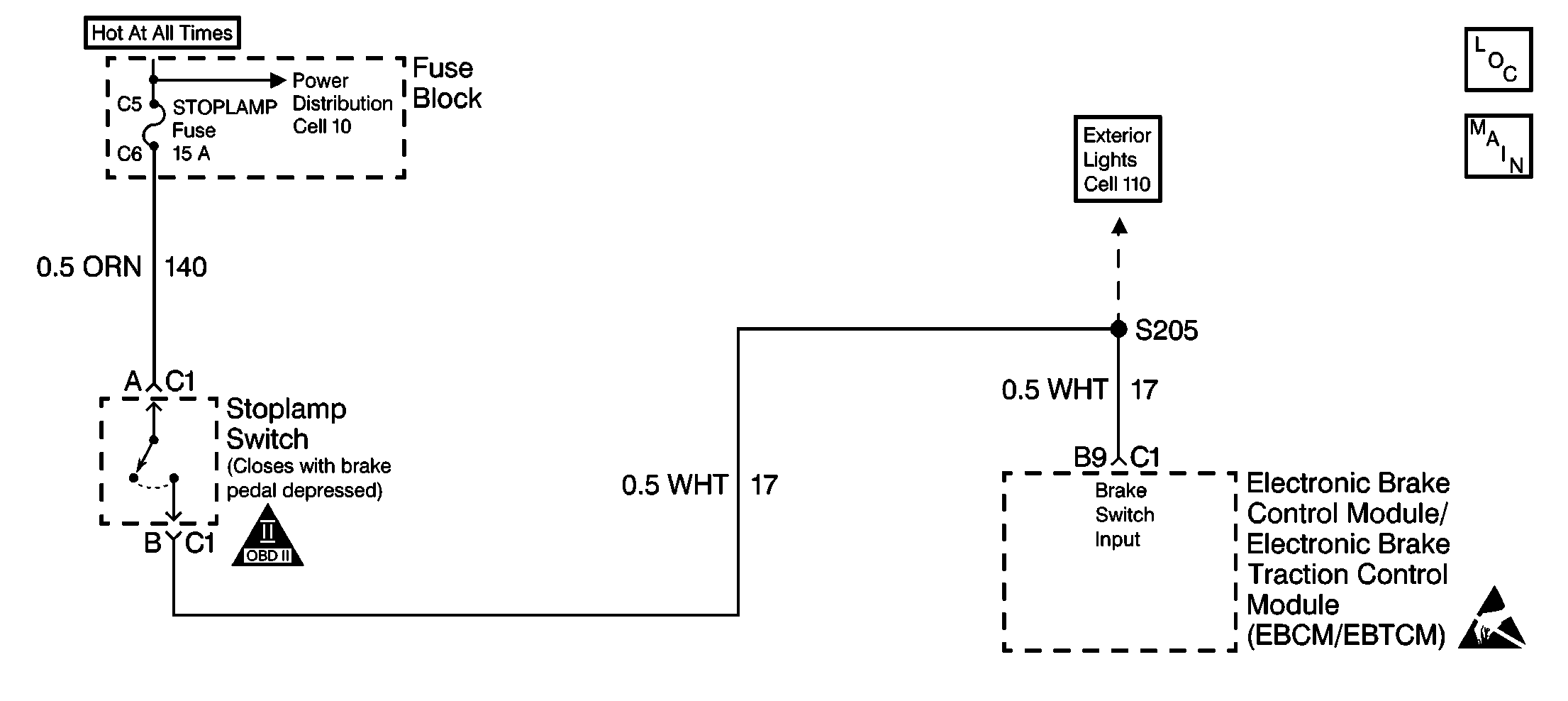
Circuit Description
DTC C1294 determines the proper operation of the brake switch. Proper operation of the brake switch is important because the brake switch activates the ABS and inhibits the TCS when the brake switch is on. The brake switch deactivates the ABS when the brake switch is off. The following conditions always occur when the brake switch is on:
| • | ABS operation is requested. |
| • | TCS operation is inhibited. |
Conditions for Setting the DTC
DTC C1294 can set if the vehicle's speed is greater than 40 km/h (25 mph).
A malfunction exists if the brake was always on during two consecutive drive cycles.
Action Taken When the DTC Sets
| • | A malfunction DTC stores. |
| • | ABS operation remains. |
| • | TCS operation is inhibited. |
Conditions for Clearing the DTC
| • | The condition responsible for setting the DTC no longer exists and the Scan Tool Clear DTC function is used. |
| • | 100 drive cycles pass with no DTC detected. |
Diagnostic Aids
Use the enhanced diagnostic function of the Scan Tool in order to measure the frequency of the malfunction. Refer to the Scan Tool manual or Scan Tool Diagnostics located in this section for the procedure. Use the Data List of the Scan Tool verify proper brake switch operation. The Data List should display the brake switch as the brake is applied within 25 mm (1.0 in) of brake pedal travel.
Thoroughly inspect any circuitry that may cause the intermittent complaint for the following conditions:
| • | Rubbed-through wire insulation |
| • | A broken wire inside the insulation |
| • | Backed out terminals |
| • | Improper mating |
| • | Broken locks |
| • | Improperly formed or damaged terminals |
| • | Poor terminal-to-wiring connections |
| • | Physical damage to the wiring harness |
Important: Zero the J 39200 test leads before making any resistance measurements.
Step | Action | Value(s) | Yes | No | ||||||
|---|---|---|---|---|---|---|---|---|---|---|
1 | Was the Diagnostic System Check performed? | -- | Go to Step 2 | |||||||
2 |
Are the rear brake lamps on? | -- | Go to Step 3 | Go to Step 5 | ||||||
3 | Disconnect the stoplamp switch connector C1. Are the rear brake lamps on? | -- | Go to Step 8 | Go to Step 4 | ||||||
4 | Inspect the adjustment of the stoplamp switch. Is the stoplamp switch adjusted correctly? | -- | Go to Step 10 | Go to Step 9 | ||||||
5 |
, engine OFF. Is the voltage equal to the specified value? | 0.00V | Go to Step 6 | Go to Step 8 | ||||||
6 |
Is there evidence of poor terminal contact, terminal corrosion, or damaged terminals? | -- | Go to Step 11 | Go to Step 7 | ||||||
7 |
Does DTC C1294 set as a current DTC during the last three drive cycles? | -- | Go to Step 12 | Go to Step 13 | ||||||
8 | Repair the short to voltage in CKT 17. Is the repair complete? | -- | -- | |||||||
9 | Adjust the stoplamp switch. Is the repair complete? | -- | -- | |||||||
10 | Replace the stoplamp switch. Is the repair complete? | -- | -- | |||||||
11 | Replace all of the terminals and connectors that exhibit the following conditions:
Is the repair complete? | -- | -- | |||||||
12 | Replace the EBCM/EBTCM. Is the repair complete? | -- | -- | |||||||
13 | The malfunction is intermittent or not present at this time. Is a concern still present? | -- | Go to Diagnostic Aids |
